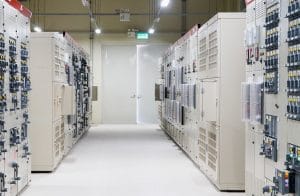 Cooling control panels (as well as various other electrical enclosures) is a vital function for most industries these days. It grows even more essential as companies continue introducing more powerful and fully integrated systems, including automated equipment and processes. Because of its importance, the efficiency with which a company’s electrical thermal management systems can remove excess heat from such enclosures largely determines that company’s level of productivity and success. For many such applications, modern custom thermal solutions, such as heat exchangers, often provide optimal results, providing high-level heat transfer capabilities to virtually any type of application in wide range of industries.
Cooling control panels (as well as various other electrical enclosures) is a vital function for most industries these days. It grows even more essential as companies continue introducing more powerful and fully integrated systems, including automated equipment and processes. Because of its importance, the efficiency with which a company’s electrical thermal management systems can remove excess heat from such enclosures largely determines that company’s level of productivity and success. For many such applications, modern custom thermal solutions, such as heat exchangers, often provide optimal results, providing high-level heat transfer capabilities to virtually any type of application in wide range of industries.
When transferring heat is more efficient
Traditionally, solutions like air conditioners and air compression units were the most common for preventing electrical enclosures from overheating. Such solutions rely on the concept of utilizing chilled air to overcome electrical waste heat within an enclosure, keeping the temperature inside well below that of the system’s maximum operating temperatures. However, chilling air is relatively costly, especially for systems that run continuously and make up the bulk of a company’s operations. By contrast, heat exchangers stop enclosures from overheating by capturing and transferring waste heat continuously. This is accomplished through more efficient and eco-friendly means that don’t require as much space or energy to accommodate.
More eco-friendly thermal solutions
Heat exchangers operate on principles of heat transfer rather than HVAC concepts. Through processes such as natural/forced convection, conduction, and/or phase-change cooling, different types of heat exchangers utilize eco-friendly cooling fluid (such as water) and looped systems to transfer and dissipate heat more efficiently. The fluid absorbs the heat and flows through the heat exchanger until it reaches a heat sink or other dissipation area where it can safely release it. Then, the fluid cycles back toward the heat source, continuing the heat transfer cycle. Besides being more efficient and cost-effective, transferring heat is also a significantly more eco-friendly process compared to conventional solutions.
Benefits of ambient cooling for control panels
By implementing custom thermal solutions such as heat exchangers to cool electrical enclosures and control panels, companies significantly streamline one of the most impactful areas of their operations. Effective thermal management is essential for maintaining productivity and avoiding costly downtime and repairs. With the help of more eco-friendly solutions, companies can ensure that their thermal management needs are consistently taken care of without worrying about exorbitant energy and maintenance costs. For more information about transferring heat for high-performance control panels, call Noren Thermal Solutions in Taylor, TX, at 866-936-6736.







